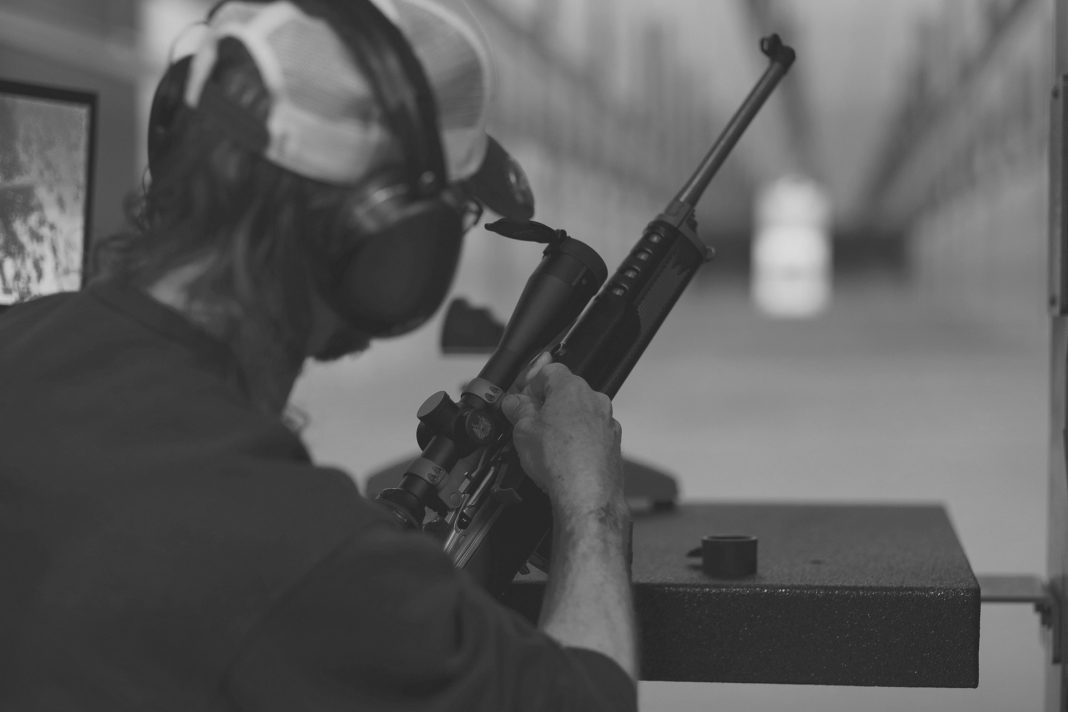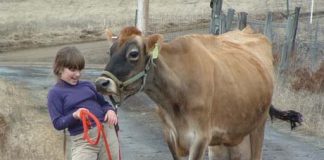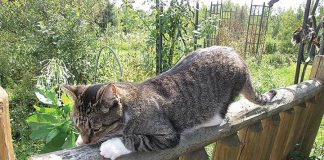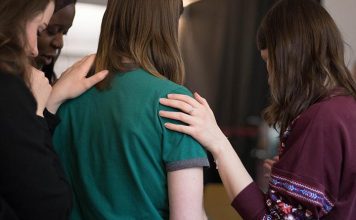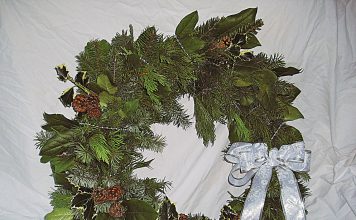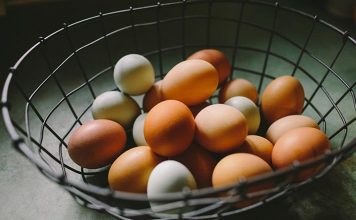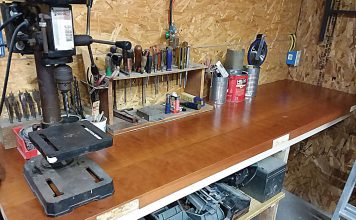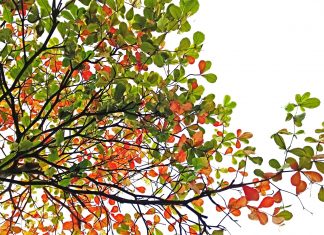 |
|
| Issue #123 • May/June, 2010 |
There is nothing else in the shooting world quite like the Appleseed Project, which combines American Revolutionary War history with rifle marksmanship and firearms safety, and in so doing finds a balance that can be equally fascinating to shooter and, yes, non-gun-owner alike. There are many levels of Appleseed training if you choose to get into the program, but the core curriculum is done over a two-day weekend. You can get a lot out of it in one day, and if you’re forced to make a choice I, for one, would take the first day to get more of their foundation, but in my opinion you really want to commit to the whole weekend.
|
Appleseed is hand in hand with RWVA, the whimsically-named Revolutionary War Veterans Association. You’ll see people there ranging from fresh-faced children, to silver-haired senior ladies you might think had taken a wrong turn on the way to a Daughters of the American Revolution meeting, to young soldiers sharpening their skills while taking a breather on the home front during the War of Their Generation.
Appleseed is not a new story at Backwoods Home, but it is a most welcome one. This magazine is built on a bedrock of American heritage, including self-sufficiency and self-determination. If you read the 20th Anniversary Issue, you know how much heat founder Dave Duffy took for allowing firearms articles in these pages…and how much advertising he lost for that decision. In the July/August 2009 issue (still available online or as a back issue), Backwoods Home ran an excellent article by Susan Hogue titled “Appleseed Boot Camp.” Ms. Hogue, a casual shooter and hunter, was reluctant to take the course at first, but ended up loving it. Dave saw that as the most important perspective for the magazine to take: that of a person in a disciplined “shooting environment” for the first time. However, he knows that some serious firearms enthusiasts read the magazine he founded, and wanted to see how it looked from that angle…so he and his daughter Annie Tuttle, who now runs the magazine, sent me for a look.
The heart of the program
In researching Appleseed before I went, I noticed one critic who said, in essence, that he had come to shoot and wished they had skipped the history lectures and just given them some pamphlets to read later or something. I fear he missed the point.
|
I’m the resident “gun guy” at the magazine, and I gotta tell ya something from the get-go: The shooting was goodand we’ll get to that momentarilybut for my money, the history was the best part of it. And when I say “for my money,” it means yes, I paid out of my own pocket to attend both days. Note, however, that females of all ages can attend for free, as can males under 21, and currently serving members of the United States Military of any age. Accommodations are made for the physically challenged, at every stage of the shooting.
I grew up in New England, a child of the deepest cold of the Cold War, no more than an hour and a half drive from where the first blood of the Patriots was shed at Lexington and Concord. From elementary school through college, we were steeped by our teachers and later, our professors in the history of the American Revolution…and I’m here to tell you that I never heard its story told in the passionate, emotional depth presented to us by the dedicated Appleseed lecturers.
The lectures were timed to give us breaks from the rigors of an immersion shooting course on the firing line, in which, except for lunch, we had only two designated breaks, one in the morning and one in the afternoon. It isn’t just dry history, with dates and times. The focus is on the human side. None of my teachers had mentioned the American girl married to a high-ranking British officer, who put her countrymen before all else and became the spy who informed the Colonials that the British were coming to take their guns, and powder, and shot. My teachers had not told us the story of the septuagenarian whoarmed with a rifle instead of a smoothbore muskethad mounted his horse and become an outrider more than 200 yards from the British lines. Alone, he would dismount, lay his rifle across his horse’s saddle, pick off a British officer, and then re-mount and ride off, oblivious to the wild shots from the out-of-range smoothbore muskets of the enraged British infantry, only to dismount later and do it again. Did your teachers tell you that the officer corps of the occupying enemy was given much better made uniforms than their rank and file troops? Their famous red coats didn’t fade as much with washing as those of the soldiers who served them, which made them easy targets for the old man and the other patriots to pick out.
The Appleseed instructors, speaking with the same passion the Founders must have felt, shared those details and much, much more. Before you attend an Appleseed, read Paul Revere’s Ride by David Hackett Fischer. It will give you a preview of the human detail that suffuses the Appleseed lectures. And when you attend, don’t be surprised if you feel a tug at the heart and the beginning of a tear in the corner of your eye.
|
What you need to know
Founded by an old-fashioned American who preferred to simply be called by his first name, Fred, Appleseed has grown into an enthusiastic grassroots movement that spreads its dual message of patriotism and armed self-sufficiency throughout the nation. It proudly proclaims itself to be all-volunteer staffed, with the minimal entry fees collected only for expenses. I’m gonna tell you what it looked like to me, participating in it as an old guy who has been shooting rifles since 1952, but first, let’s talk about a couple of core principles you really want to have nailed down before you attend. One is what they call The Six Steps to making an accurate shot with a rifle, and the other, even more important, is their safety rules.
Four rules of safety
The rifle and musket won the American Revolution because they were deadly weapons that killed the occupation forces of the enemy. An organization that combines riflery with the history of the Revolution has to place great emphasis on firearms safety. These people do just that. Appleseed pounds on four rules of safety that they want every participant not only to be able to repeat on demand, but to follow rigorously.
1. Always keep the rifle’s muzzle in a safe direction. This might be the designated backstop, usually an earthen berm. It might be skyward. It might be muzzle down, but in that instance it will be pointed at dirt, not concrete which can send shrapnel in all directions if struck by a bullet.
2. Do not load until command. Appleseed is a “cold range,” in which the firearms are always unloaded until the command to load and make ready to fire is given. Magazines will be removed, actions will be open, manual safeties will be engaged (if the given rifle’s design allows it to be “on-safe” with the action open), and a brightly colored plastic “chamber flag” (provided) will be inserted in the rifle’s chamber when it is at rest on the ground or shooting mat. Leave it with the ejection port up, so all and any can see it is unloaded. The rifle is not to be handled by anyone until command.
|
3. Keep your finger off the trigger until you are on target. Violation of this simple maxim probably causes more tragic gun accidents than any other safety transgression. Quite simply, the finger should be outside the trigger guard unless and until you are in the very act of intentionally firing a gunshot.
4. Make sure all of those around you follow the safety rules. Your own perfect adherence to safety rules won’t save you if some careless clown or foolish show-off crosses you with the muzzle of his gun. At an Appleseed shoot, everyone shares responsibility for safety.
Now, to this old shooter, “the four rules” have long been those of Jeff Cooper, who quantified them as (1) Treat every firearm as if it is loaded; (2) never allow the muzzle to point at anything you are not prepared to destroy; (3) keep your finger off the trigger until you are on target (same as Appleseed); and (4) be certain of your target and what is behind it before you pull the trigger. When asked to recite “the four rules,” I almost had a cognitive dissonance attack trying to utter Appleseed’s instead of Cooper’s. Well, “when in Rome.” The easiest thing, and probably the best thing, is to follow Appleseed’s four safety rules and Col. Cooper’s four.
Six steps
Appleseed folks have a saying: “We’re not teaching basic principles, we’re teaching foundational principles.” We could quibble about the semantics, but you get the drift. Without a strong foundation, nothingincluding skillis going to rise quickly or stand for long. Appleseed teaches what it calls The Six Steps to firing a good shot. Something “basic” is simple and introductory, necessarily so when it is assumed that people completely new to the discipline will be among the students. But something “foundational” is something you can build on all your life, strong enough to support advanced techniques as well as basic ones. The training at Appleseed, I humbly submit, is basic and foundational.
|
1. Sight alignment. With iron sights, the front post is centered in the rear notch or aperture.
2. Sight picture. This is what the shooter sees when the sight alignment is superimposed over the spot on the target we want to hit.
3. Respiratory pause. Appleseed teaches a controlled breathing pattern in which the shooter tries to make the shot at the point where the breath is at its trough, that is, exhalation is complete, in hopes of maximizing the steadiness of the body’s platform at the time of the shot.
4. (A) Focus your eye on the front sight. We can only sharply see on one focal plane at once, and with an iron sight rifle we’re dealing with three such planes: those of the front sight, the rear sight, and of course, the target. Maintaining focus on the front sight minimizes unnoticed waver of the sights (and therefore, the shot) off target. With an optical sight, we focus on the reticle (i.e., a scope’s crosshairs).
(B) Focus your mind on keeping the front sight on the target. As you press the trigger, you’re concentrating on the sight picture. This allows you to adjust for a moving target, and lets you catch any body waver that might move the sights off that target.
5. Squeeze the trigger. We’re talking about a straight-back press of the trigger that doesn’t jerk the firearm in any direction. It’s simple geometry: a tiny fraction of an inch movement of the sights out of alignment can result in a miss by inches or even feet downrange, at rifle distance.
6. Follow through. Unless your firing hand is needed to operate the feed mechanism, keep your finger on the trigger so you can feel it re-set for the next shot. Keep the sights on target as much as possible. This may or may not let you monitor the hit depending on vision and gun movement from recoil, but will definitely help you get back on target faster for a follow-up shot.
The Appleseed experience
My trip to an Appleseed at Hernando Sportsmen’s Club in central Florida taught me the wisdom of reading the organization’s webpage and its good advice on what to bring (www.appleseedinfo.org). Bring water and Gatorade. All-weather clothing, ’cause these folks shoot rain or shine…one fellow attendee used the word “monsoons” to describe the weather the first day at Hernando. A folding chair makes the lectures more comfortable. Check to see if the host range has a covered firing line: if not, in sunny weather, something like a beach umbrella can be a Godsend. You’ll need a shooting mat: I saw everything from simple foam mats to beach towels, but was delighted with the performance of the dedicated Blackhawk shooting mats my significant other and I brought; they double as padded rifle cases. Bring ear and eye protection, of course, and some sort of billed cap to keep sun out of the eyes, rain off the shooting glasses, and spent brass from landing between safety lens and eyeball.
|
Stated live-fire curriculum is usually 150 rounds for the first day and 250 for the second; bring 500 rounds and you’re covered if you get some extra shooting time as a bonus. .22 Long Rifle is allowed, and is by far the most popular choice. Its soft recoil and mild sound signature don’t distract from the marksmanship task, particularly with new shooters, and of course, it’s by far the least expensive. That said, though, expect to see everything from deer rifles to military rifles that span a range of WWI vintage through modern state of the art.
The object of the exercise is to pass the AQT, Appleseed’s extrapolation of the Army Qualification Test. To allow shooting to be done on more ranges around the country, all firing is at only 25 meters, using targets that are scaled down to represent military-style bobber targets at up to 400 yards. While this won’t factor in the trajectory/bullet drop or wind drift or mirage elements of a shot a true four football fields away, it gets you accustomed to hitting a target that small, thus permitting the shooter to focus better on those “six steps.”
In some stages of the qualification, reloads are required under time. This means you want a rifle with a box magazine, and at least two magazines with you. The qualification has been passed with bolt action rifles, and Appleseed legend has it that the highest score in the organization’s history was shot by an old smallbore rifle competitor in his 70s, using a bolt action .22 with iron sights. That said, though, if you don’t have as many decades of habituation rapidly working the bolt as he did, a semiautomatic will greatly simplify your task. The finger never has to leave the trigger. The fewer component tasks you have to accomplish in a string of shots, the more you can concentrate on honing your skill at each of those tasks.
|
The most popular Appleseed rifle by far, nationwide and certainly at the shoot I attended, is the Ruger 10/22 semiautomatic. Fitted with a 10 or 12 dollar fabric loop sling, which when properly secured to the upper part of the support arm steadies the rifle in virtually any shooting position, and with a Garand-like adjustable aperture sight from Tech-Sight (www.tech-sights.com), you have the LTR, or Liberty Training Rifle, the “unofficial official gun” of Appleseed. Telescopic sights are allowed, and are a definite benefit to those of us with older eyes.
I wrote three entries in my Backwoods Home blog detailing my experience at Appleseed, still archived there (Feb. 1-6, 2010) at www.backwoodshome.com/blogs/massadayoob. I won’t rehash all those comments in the limited space I have here, but to recap briefly: Check your hardware before you go. I had sighted in, but neglected to tighten scope mount screws, and the mount started walking off my rifle, constantly moving point of aim/point of impact throughout the first day, and costing me my first qualification score. Feel free to ask the range officials any questions you might have about the rules. On my second run, I qualified, but had used the extended magazine on my 10/22 as a unipod in contact with the ground when firing from prone, and that turned out to be a no-no that disqualified the score. The third time was the charm, however. Shooting the targets out of sequence costs you points, too. How do I know this, you ask? Sigh…just trust me, I know this.
I was very happy with the performance of my .22, a Ruger 10/22 Squirrel Rifle built by Kay Clark-Miculek at Clark Custom (www.clarkcustomguns.com). Its sweet trigger pull and short, fluted Douglas barrel, all mounted in a Brownell’s speed shooting stock under a 3-9X variable power Tasco scope set at 8X, allowed the rifle to put all its CCI Mini-Mag bullets into the same hole when I did my part. But many a shooter has qualified with an ordinary, off-the-rack 10/22 with iron sights. Marlin .22s have a strong following, as well. Bring at least one rifle per shooter. A spare is always good in case of a breakdown. Gun-sharing won’t work because everyone usually shoots at the same time. No suitable rifle? Reach out to the host, listed with contacts on the Appleseed website, and they can probably arrange a loaner gun.
|
The object of the exercise is to score 210 points or better on a 40-shot course that has 250 points possible, with the 10 shots on the smallest, hardest targets given double value. This earns the coveted Rifleman’s Patch. Of the couple dozen of us who showed up at Hernando (less than half the usual turnout, probably due to the horrible weather), only four earned the patch. It’s a worthy goal…but it’s not really what Appleseed is about.
Appleseed is a celebration of American history and core values: independence, self-sufficiency, and a willingness to sacrifice for one’s country and community. The Appleseed Project wants to see a return to a collective national pride in our country’s roots, and to its proud past history as A Nation of Riflemen. Appleseed’s passionate teaching of Revolutionary War history with an emphasis on the stories of the individual Americans’ contributions to freedom and to the lifestyle we now enjoy is, I think, its strongest contribution. The solid shooting instruction is simply a very tasty icing on that soul-nourishing cake.
The Appleseed values are strong ones, and are shared by the whole Backwoods Home team. That’s why Appleseed is the theme of this issue’s cover. For more information on Appleseed and for seminar schedules visit www.appleseedinfo.org.


